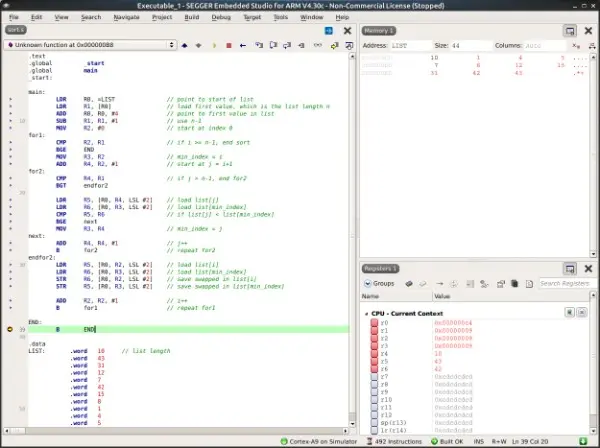The assignment deals with implementing a sorting algorithm in ARM assembly in order to sort a given array in memory. The array is stored in the data section as a number that indicates the number of elements followed by the actual array elements. The array is sorted in ascending order in place by using bubble sort. The following code is an illustration of the quality of the solution you receive when you avail ARM assembly assignment help from us.
Implementing Sorting Algorithms in ARM Assembly

Source Code
.text
.global _start
.global main
_start:
main:
LDR R0, =LIST // point to start of list
LDR R1, [R0] // load first value, which is the list length n
ADD R0, R0, #4 // point to first value in list
SUB R1, R1, #1 // use n-1
MOV R2, #0 // start at index 0
for1:
CMP R2, R1 // if i >= n-1, end sort
BGE END
MOV R3, R2 // min_index = i
ADD R4, R2, #1 // start at j = i+1
for2:
CMP R4, R1 // if j > n-1, end for2
BGT endfor2
LDR R5, [R0, R4, LSL #2] // load list[j]
LDR R6, [R0, R3, LSL #2] // load list[min_index]
CMP R5, R6 // if list[j] < list[min_index]
BGE next
MOV R3, R4 // min_index = j
next:
ADD R4, R4, #1 // j++
B for2 // repeat for2
endfor2:
LDR R5, [R0, R2, LSL #2] // load list[i]
LDR R6, [R0, R3, LSL #2] // load list[min_index]
STR R6, [R0, R2, LSL #2] // save swapped in list[i]
STR R5, [R0, R3, LSL #2] // save swapped in list[min_index]
ADD R2, R2, #1 // i++
B for1 // repeat for1
END:
B END
.data
LIST: .word 10 // list length
.word 43
.word 31
.word 12
.word 7
.word 42
.word 15
.word 8
.word 1
.word 4
.word 5
Related Samples
At ProgrammingHomeworkHelp.com, we offer specialized support for Assembly Language assignments, providing students with expertly crafted sample solutions. Our platform features a range of related samples that demonstrate best practices and solutions for various Assembly Language tasks. Whether you're tackling low-level programming challenges or need guidance on specific Assembly Language concepts, our samples serve as valuable resources to enhance your understanding and performance. Trust ProgrammingHomeworkHelp.com to assist you in mastering Assembly Language and achieving academic success with ease.
Assembly Language
Assembly Language
Assembly Language
Assembly Language
Assembly Language
Assembly Language
Assembly Language
Assembly Language
Assembly Language
Assembly Language
Assembly Language
Assembly Language
Assembly Language
Assembly Language
Assembly Language
Assembly Language
Assembly Language
Assembly Language
Assembly Language
Assembly Language
